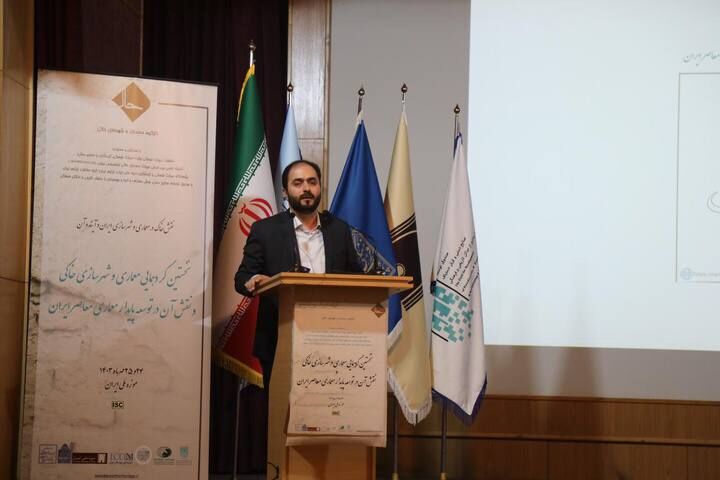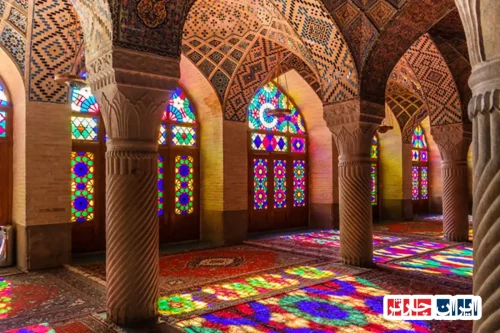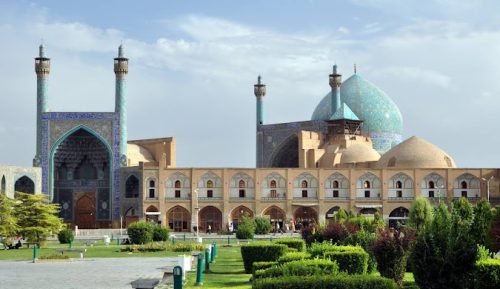News Source : https://www.irna.ir/news/85629103/%D9%85%DB%8C%D8%B1%D8%A7%D8%AB-%D9%81%D8%B1%D9%87%D9%86%DA%AF%DB%8C-%D8%A8%D8%A7%DB%8C%D8%AF-%D8%A8%D8%A7%D9%81%D8%AA-%D9%87%D8%A7%DB%8C-%D8%AA%D8%A7%D8%B1%DB%8C%D8%AE%DB%8C-%D8%A8%D8%A7-%D9%85%D8%A7%D9%84%DA%A9%DB%8C%D8%AA-%D8%B4%D8%AE%D8%B5%DB%8C-%D8%B1%D8%A7-%D8%A7%D8%AD%DB%8C%D8%A7-%DA%A9%D9%86%D8%AF
Cultural Heritage Must Revitalize Historical Fabrics with Private Ownership
Revitalizing historical fabrics with private ownership is one of the most important responsibilities of modern society. This action not only helps preserve cultural and historical values but also improves the quality of life in urban areas. emphasizes the importance of maintaining historical fabrics with private ownership in line with preserving and revitalizing the national heritage. These buildings are symbols of our history and national identity, which must be preserved for future generations. Moreover, supporting private owners in the process of revitalizing historical buildings can provide motivation for maintaining these places. Therefore, focusing on private historical fabrics not only helps preserve cultural heritage but can also lead to sustainable development and attract tourism.
The Importance of Revitalizing Historical Textures with Private Ownership in Preserving Cultural Heritage
Revitalizing historical textures with private ownership plays a vital role in maintaining and passing cultural heritage to future generations. This action not only aids in preserving the architectural and historical values of places but also fosters a sense of belonging and pride among private owners. By focusing on these types of textures, we can prevent unnecessary destruction and sustain cultural values in a lasting manner. Furthermore, supporting private owners in the revitalization process can provide motivation for better maintenance and care of these sites.
The Role of Supportive Laws in Revitalizing Private Historical Buildings
Supportive laws are crucial in the process of revitalizing historical buildings with private ownership. These laws must be clear and effective to encourage owners to maintain and revitalize historical buildings. By drafting regulations that specify the rights and obligations of owners, we can ensure that these buildings are preserved and restored appropriately. Additionally, creating financial and facilitative incentives for private owners can provide a strong motivation for undertaking this responsibility.
The Economic Benefits of Revitalizing Private Historical Textures
Revitalizing historical textures with private ownership not only aids in preserving cultural heritage but also has significant economic benefits. This action can attract domestic and foreign tourists, thereby boosting the regional economy. Furthermore, restoring historical buildings can create new job opportunities and strengthen local handicrafts. Increased property values in revitalized areas are also among the economic benefits of this process.
Successful Experiences in Revitalizing Private Historical Textures in Iran
There is a rich history of successful experiences in Iran in revitalizing historical textures with private ownership. Examples of these experiences include the restoration of historical houses in cities like Isfahan, Shiraz, and Yazd, which have had positive impacts on preserving cultural heritage and economic development in these areas. These projects demonstrate that with appropriate support for private owners, beneficial outcomes can be achieved that benefit both cultural heritage and the local community.
Challenges of Revitalizing Historical Textures with Private Ownership
Revitalizing historical textures with private ownership faces multiple challenges. One of the main challenges is securing the necessary financial resources for restoration and maintenance of these sites. Additionally, differences in viewpoints and potential tensions between private owners and relevant authorities can be obstacles to advancing this process. Moreover, the need for appropriate expertise and technical knowledge for precise restoration according to cultural heritage principles is another challenge in this field.
The Importance of Collaboration Between Government and Private Owners in Revitalizing Historical Buildings
Success in revitalizing historical textures with private ownership requires close collaboration between the government and private owners. The government can increase owners’ inclination to preserve and revitalize these sites by providing financial incentives, administrative facilities, and creating suitable legal frameworks. Meanwhile, private owners should demonstrate their commitment to maintaining and revitalizing historical buildings and cooperate with relevant authorities. Creating an effective collaboration framework can facilitate the revitalization process and reduce obstacles.
The Impact of Revitalizing Historical Textures on National and Cultural Identity
Revitalizing historical textures with private ownership plays a significant role in preserving and strengthening the national and cultural identity of a country. These textures represent the history, culture, and art of the nation, and their restoration means reviving parts of the national identity. By preserving these historical sites, we can encourage artists, researchers, and the general public to better understand and value cultural heritage. Additionally, these actions can help transmit cultural values to future generations.
Modern Methods in Revitalizing Historical Buildings with Private Ownership
Utilizing modern methods in revitalizing historical buildings with private ownership can enhance the efficiency and quality of this process. New technologies, such as 3D scanning, the use of modern building materials, and advanced protective methods, can effectively preserve and accurately restore historical sites. Additionally, leveraging international experiences and knowledge exchange with other countries can help improve restoration techniques and methods.
Sustainable Planning for the Future of Private Historical Textures
To ensure long-term preservation and maintenance of historical textures with private ownership, careful and long-term planning is required. This planning should include strategies for continuous financial provision, education for owners and managers of historical sites, and the creation of crisis management plans for dealing with natural and human-made disasters. Additionally, promoting public awareness about the importance of preserving cultural heritage and encouraging social participation can aid the sustainability of these actions.
The Role of Education and Awareness in Revitalizing Private Historical Textures
Education and awareness play a fundamental role in the process of revitalizing historical textures with private ownership. Providing training courses for private owners on restoration techniques, principles of cultural heritage conservation, and sustainable management of historical sites can improve the quality of revitalization and maintenance of these buildings. Moreover, conducting informational and promotional campaigns within the community can enhance the public’s understanding and appreciation of the importance of preserving and revitalizing cultural heritage.
Frequently Asked Questions
- What is cultural heritage and why is it important?
- Cultural heritage includes buildings, textures, and historical artifacts that have historical, cultural, and social significance and play a crucial role in preserving national identity and sustainable development.
- What is the CEO of the Development and Revitalization Fund’s view on historical sites?
- He believes that cultural heritage should move beyond merely revitalizing government buildings and focus on restoring privately-owned historical textures.
- When was the National Heritage Preservation Law passed and why is it important?
- This law was passed in 1930 by the National Assembly and is one of the first legislations enacted to preserve cultural heritage in Iran, still in effect today.
- How has the number of registered buildings increased over recent years?
- Over the past fifty years, initially one hundred buildings were registered, and since 1979, several thousand buildings have been registered.
- Why are many historical textures seen as threats?
- Because the prevailing view of historical textures is that they are not opportunities but rather threats, and cultural heritage governance is limited to registering artifacts.
- What are the challenges in cultural heritage governance?
- Some challenges include weak laws, legal inflation, and insufficient awareness among stakeholders about their domain and responsibilities.
- How many properties does the Development and Revitalization Fund for private historical buildings control?
- The fund controls over 10,000 privately-owned buildings that need revitalization and restoration.
- Why is there a need to focus on privately-owned buildings?
- Because the majority of historical buildings are under private ownership, and with suitable laws, these individuals can be supported in preserving and revitalizing structures.
- What distinguishes the historical texture of Gorgan city?
- The historical texture of Gorgan city was registered eighty years ago and is considered one of the first registered textures in the country.
- How does the Development and Revitalization Fund define its future plans?
- The fund intends to participate in promotional events in addition to revitalizing historical textures, creating the necessary cultural grounds for preserving and revitalizing buildings.
- What is the significance of the architecture and earthen urban development gathering?
- This gathering plays an essential role in the sustainable development of contemporary Iranian architecture and examines the role of earthen urban development in this field.
- How can a balance between historical and economic values of historical buildings be achieved?
- By balancing historical, social, and economic values and by establishing appropriate laws, this balance can be achieved.
- What is the role of laws in cultural heritage governance?
- Laws play a crucial role in defining and ensuring the preservation of cultural heritage, but there is a need to strengthen and improve them for more effective governance.
- Why should post-registration actions for historical artifacts be considered?
- Because preserving a building is not limited to registration, post-registration actions like restoration and revitalization are necessary for preserving and maintaining structures.
- When will the architecture and earthen urban development gathering take place?
- This gathering will take place on the 24th and 25th of October 2024, from 8 AM to 4 PM at the National Museum.
- Who will participate in this gathering?
- Key speakers and experts such as Alondo Assamo Lazar, Maddalena Akenza, Rasoul Vatandoust, Mohammad Mansour Falamaki, Seyyed Mohammad Beheshti, Mehdi Mojabi, Faramarz Parsi, and Eskandar Mokhtari will participate.







